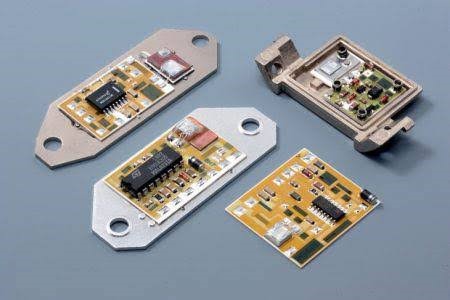Ceramic printed circuit boards (PCBs) are constructed of extremely high thermal conductivity elements such as alumina, aluminum nitride, and beryllium oxide. They can swiftly transfer heat away from hot spots and disperse it across the entire surfaces. Today, I will share more about What is Ceramic PCB and why you should go for it. Let’s have a look!

What is Ceramic PCB
Ceramic PCBs are made using LAM technology, which stands for laser rapid activating metallization. Therefore, ceramic printed circuit boards are very versatile and might even substitute a whole conventional printed circuit board with a simplified construction and enhanced functionality.
The word “ceramic” denotes to a category of substances with comparable chemical compositions and mechanical properties.
For its ceramic production, FX PCB opts for automated processing. Controlling and eliminating oxidation is possible. As a result, our ceramic PCBs are of excellent performance.
Different Types of Ceramic Printed Circuit Board
Depending on the construction method, ceramic PCBs have been divided into three kinds. They are:
- High Temperature Ceramic PCB
- Low Temperature Ceramic PCB
- Thick Film Ceramic PCB
High Temperature Ceramic PCB
This sort of PCB is made for extreme heat and is often known as a high temperature co-fired ceramic (HTCC) board. Such circuit components are manufactured in a different way. To make new ceramics, a solvent, plasticizer, sticky, alumina ( al2o3), and lubricants are mixed together.
After developing the fresh ceramic, it is then coated and circuit drawing onto molybdenum or tungsten materials is placed.
After that, the circuits will just be burnt for 48 hours at temperatures ranging from 1600 to 1700 degrees Celsius. Baking would take place in a particular gaseous atmosphere containing hydrogen gas.
Low Temperature Ceramic PCB
This sort of PCB is intended for use at low heat and it is also known as a low heat co-fired ceramic (LTTC) circuit. The low-temperature ceramic PCB assembly process varies from the increased temperature ceramic PCB production process. The low-temperature ceramic PCB is made with an adhesive material and crystallized glass. Using gold paste, both ingredients are put to a metal plate.
The board will then be laminated and then cut. This will be followed by baking the circuit in a gaseous type of oven at 900 degrees Celsius.
The low-temperature ceramic PCB offers a greater shrink compliance and far less surface roughness than the traditional PCB. Moreover, LTTCs feature good thermal stability and mechanical strength than most other kinds, such as HTCCs. While operating with heat-free items such as LED lights, the low-temperature PCB is preferred because of its thermal benefit.
Thick Film Ceramic PCB
This sort of PCB is made by covering ceramic foundation material with dielectric as well as gold pastes. Once both mixtures are applied, the substance will just be heated to 1000 degrees Celsius or less than that.
It is recommended to apply a thick coating ceramic since it prevents the metal from rusting. Ceramic PCB manufacturers may utilize replaceable conductors, semiconductors, electrical capacitances, and resistive elements on the ceramic board as just a consequence of this technical innovation. If the producer is serious about rusting, they will choose this sort of steel for their products. However, the conductivity layer cannot be deeper than 13 microns. To know more about Ceramic PCB, Click here.
Features of Ceramic PCB
These are made from electronic ceramics, and it can be shaped and sized in a variety of forms and dimensions. It is widely used in various sectors that require superior circuit boards because of its strong temperature resistance and electrical insulation capability.
Some of its additional features include:
- Highly conductive to heat
- Dielectric loss as well as low dielectric constant
- It has an excellent chemical resistance
- The component’s high heat expansion coefficient
Benefits of Using Ceramic Printed Circuit Boards
As a result of its many advantages, ceramic PCBs are considered the finest solution for a wide range of applications. So here are some reasons why ceramic PCBs have become a popular pick.
- A strong heat expansion coefficient is a characteristic of ceramic PCBs. Despite their high heat conductivity, ceramic PCBs are a great choice for many applications.
- Under tremendous pressure, ceramic printed circuit boards (PCBs) are very flexible and operate well even under harsh conditions.
- They are suitable for heavy-duty applications because of their durability. As a result, heat would be much less inclined to move through into the base, safeguarding the circuit board elements.
- A wide range of sectors benefit from the performance and reliability of ceramics, even under challenging weather and temperature conditions.
- A ceramic material with a frequency range, including such aerospace and medical, can be utilized to transmit data and electrical signals at great frequencies.
- Ceramic PCBs are cost-effective because they increase performance while decreasing the complexity of production and construction. The cost of ceramic PCBs is indeed lower when contrasted to those with a metal (Cu/AL) core.
Final Thoughts
So, all of these conclude our explanation about ceramic PCB. It is also one of the most common and newest PCB kinds in the market that has been most widely used. As a result of its thermal conduction and other characteristics, it has become a preferred substrate material in the telecommunication, defense, medical, and industrial applications.
It’s important to choose a ceramic circuit board manufacturer that seems to have a high level of processing. For optimum thermal conduction and heat resistance, the oxidation process must always be kept under control.
